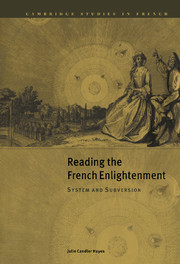Book contents
- Frontmatter
- Contents
- Acknowledgments
- Author's note
- Prologue – despotic Enlightenment
- Introduction – the critique of systematic reason
- Chapter 1 “Système” – origins and itineraries
- Chapter 2 The epistolary machine
- Chapter 3 Physics and figuration in Du Châtelet's Institutions de physique
- Chapter 4 Condillac and the identity of the other
- Chapter 5 Diderot – changing the system
- Conclusion – labyrinths of Enlightenment
- Notes
- Bibliography
- Index
- CAMBRIDGE STUDIES IN FRENCH
Chapter 4 - Condillac and the identity of the other
Published online by Cambridge University Press: 22 September 2009
- Frontmatter
- Contents
- Acknowledgments
- Author's note
- Prologue – despotic Enlightenment
- Introduction – the critique of systematic reason
- Chapter 1 “Système” – origins and itineraries
- Chapter 2 The epistolary machine
- Chapter 3 Physics and figuration in Du Châtelet's Institutions de physique
- Chapter 4 Condillac and the identity of the other
- Chapter 5 Diderot – changing the system
- Conclusion – labyrinths of Enlightenment
- Notes
- Bibliography
- Index
- CAMBRIDGE STUDIES IN FRENCH
Summary
In 1749, the year of Du Châtelet's death, the year Buffon published the first three volumes of L'Histoire naturelle, Etienne Bonnot, abbé de Condillac, delivered what many considered the final blow to the activity of “systematizers,” his Traité des systèmes. The Traité became an important reference point for d'Alembert in the Discours préliminaire and would furnish the substance for two of the Encyclopédie's articles in the series “Systême” (rubrics Métaphysique and Philosophie). In the twentieth century, despite strong interest in his approach to Lockean empiricism, his linguistic theories, and his logic, there has been relatively little analysis of the Traité per se. In this chapter, I shall look first at some general issues in Condillac's language theory and logic, in particular at his form of genealogical critique and his understanding of the key notions of analogy and identity, before turning to the Traité des systêmes. From Buffon and d'Alembert to Du Châtelet, we have been made aware of the degree to which the split between analysis and synthesis, the linear and the simultaneous, method and system, constitutes a founding problematic in Enlightenment thought. It is no less so in Condillac and, as we shall see in the following chapter, in Diderot. Certainly one aspect of Condillac's thought that makes him interesting in this context is what Foucault called his “hesitation” between the two.
- Type
- Chapter
- Information
- Reading the French EnlightenmentSystem and Subversion, pp. 111 - 141Publisher: Cambridge University PressPrint publication year: 1999



